This 30-minute Low FODMAP Pad Thai with Shrimp is a Thai restaurant-inspired dish featuring rice noodles, shrimp, a simple sauce, and FODMAP-friendly amounts of cabbage and green bell peppers.
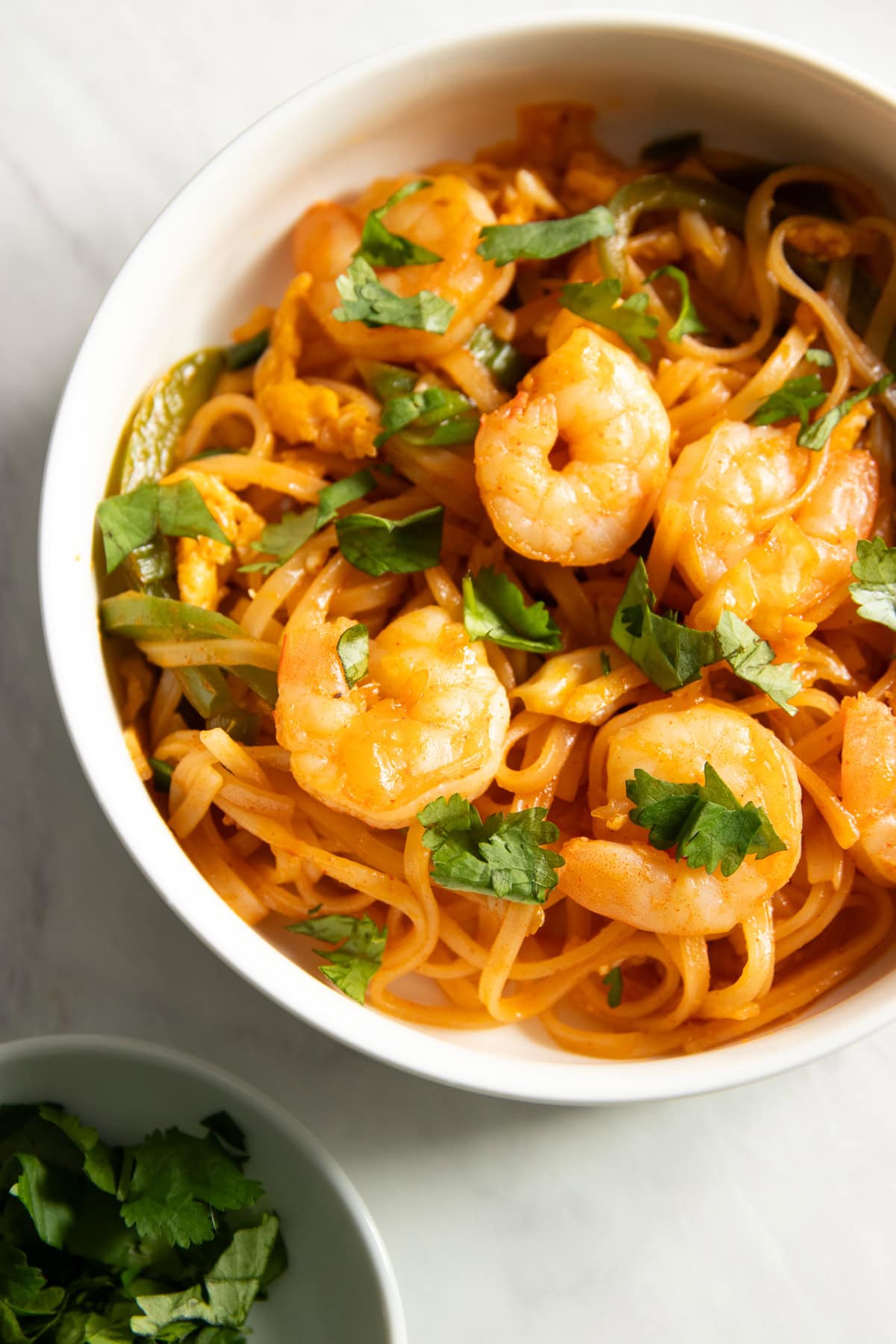
I published the first iteration of this recipe in 2018 after taking a fantastic Thai cooking class at Sawatdee in the Twin Cities from the restaurant's founder, Supenn Harrison.
She taught me how to prepare a handful of Thai recipes and layer ingredients to achieve a harmonious balance of sweet, salty, sour, and spicy flavors—quintessential of many Thai and other Southeast Asian dishes.
Since then, Monash University has retested and changed the FODMAP status and low FODMAP serving sizes of some of the ingredients I originally used. I have modified and updated the recipe to reflect these changes.
Although delicious and flavor-packed, Pad Thai, which we find in many restaurants, often contains higher FODMAP ingredients such as onion and garlic.
While many versions of Pad Thai contain tamarind (and some may call it essential to the dish), Supenn showed us a version of Pad Thai that did not use tamarind. Her method inspired this low-FODMAP Pad Thai recipe.
Ingredients
To make this low FODMAP Pad Thai, be sure to add these ingredients to your shopping list:
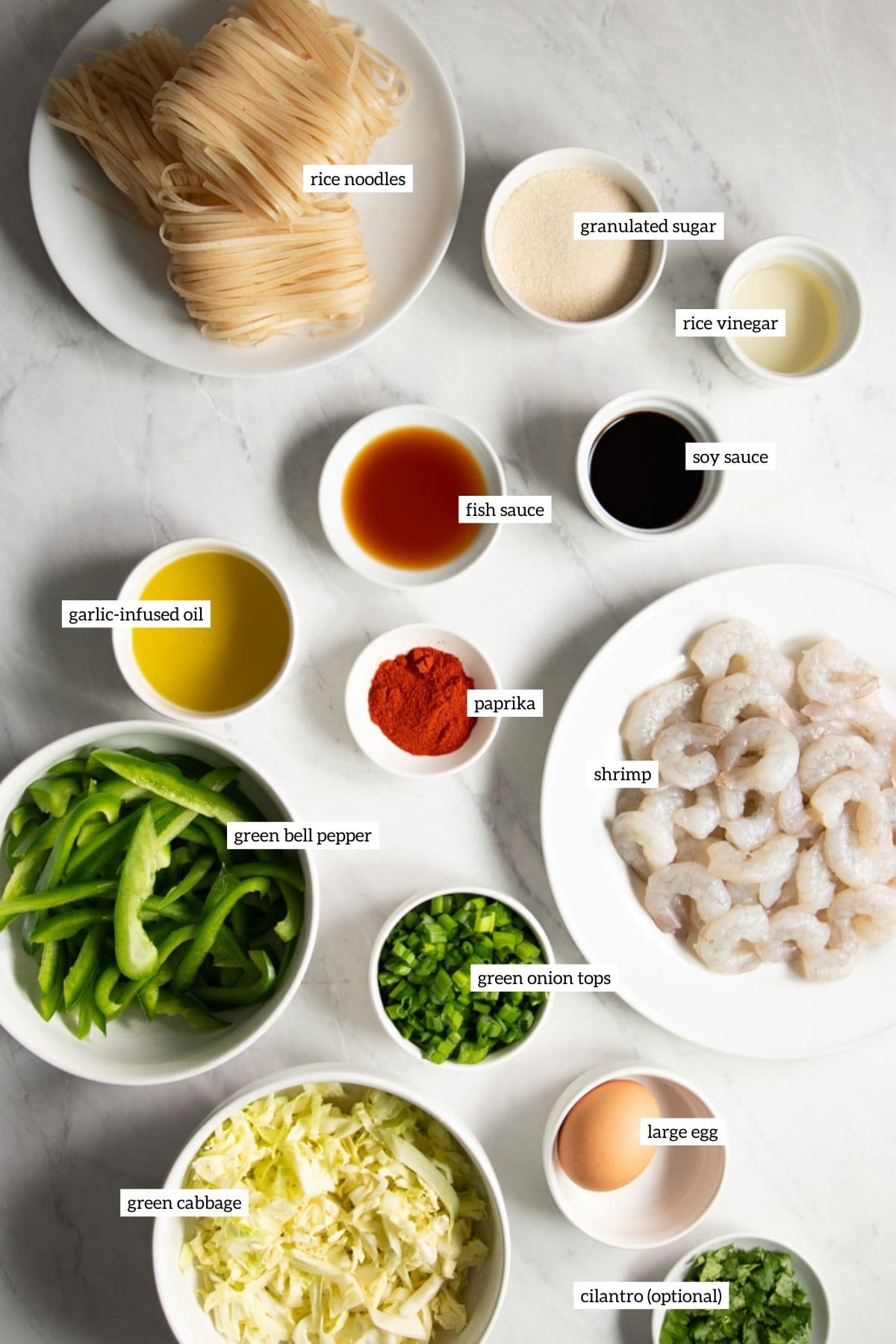
- Rice noodles - 8 ounces uncooked
- Granulated sugar - ¼ cup
- Plain rice vinegar - 2 tablespoons
- Reduced-sodium soy sauce (or tamari for gluten-free) - 2 tablespoons
- Fish sauce - 1 tablespoon
- Ground paprika - 2 teaspoons
- Garlic-infused olive oil - 2 tablespoons + 1 teaspoon
- Green bell pepper - 1 medium
- Green cabbage - 1.5 cups shredded
- Uncooked medium or large shrimp - 1 pound (454 grams)
- Green onion tops (green parts only) - ½ cup sliced
- Egg - 1 large
- Cilantro - optional garnish
Low FODMAP Notes
In this section, I share information for ingredients that are either frequently asked about or have suggested serving sizes to remain low FODMAP. We each have unique tolerance levels and nutritional needs. Please listen to your body (and, if possible, work with a FODMAP-trained dietitian) to determine what is best for you. For more low FODMAP serving size info, please refer to the Monash FODMAP app and FODMAP Friendly website or app.
Rice noodles - A low FODMAP serving is up to 1 cup or 220 grams of cooked noodles.
Granulated sugar (or white sugar) is low FODMAP in servings up to ¼ cup or 50 grams.
Rice vinegar (or rice wine vinegar) is a type of low FODMAP vinegar. The suggested serving size is 2 tablespoons or 42 grams.
Soy sauce, or soya sauce, is low FODMAP in servings of 2 tablespoons or 42 grams. Soy sauce contains small amounts of wheat in levels that should be tolerated by most with IBS. If you require a gluten-free or wheat-free diet, tamari sauce is a suitable alternative.
To help prevent dishes from getting too salty, I often prefer to cook with the reduced-sodium versions. Sodium (or salt) is a mineral and does not impact FODMAP (carbohydrate) levels.
Fish sauce is a common condiment used in Southeast Asian cooking. The low FODMAP serving is 1 tablespoon or 44 grams. Larger amounts contain moderate amounts of mannitol and GOS.
Paprika (ground sweet paprika) is low FODMAP in servings of 1 teaspoon or 2 grams.
Garlic-infused oil is a popular way to add low FODMAP garlic flavor on the low FODMAP diet. My current favorite is Colavita Roasted Garlic Olive Oil (technically a garlic-flavored oil) that Monash University has confirmed to be low FODMAP. Learn more about why garlic-infused oil is okay in my Low FODMAP Garlic and Onion Substitutes post.
Green bell pepper is low FODMAP in servings of 1 cup, ¼ medium, or 75 grams. Larger servings (more than 3.5 cups) contain higher amounts of fructan.
Green (common) cabbage: A low FODMAP serving is ¾ cup or 75 grams.
Green onion tops - the green part of green onions - are low in FODMAPs and should be tolerated by most on the low FODMAP diet in servings up to ¾ cup or 75 grams. Be sure to avoid the white bulb, which is high in FODMAPs. Pro tip: use kitchen shears to quickly snip the tops into thin slices. Learn more → Low FODMAP Garlic and Onion Substitutes.
Cilantro is low FODMAP in servings of 1 cup or 16 grams.
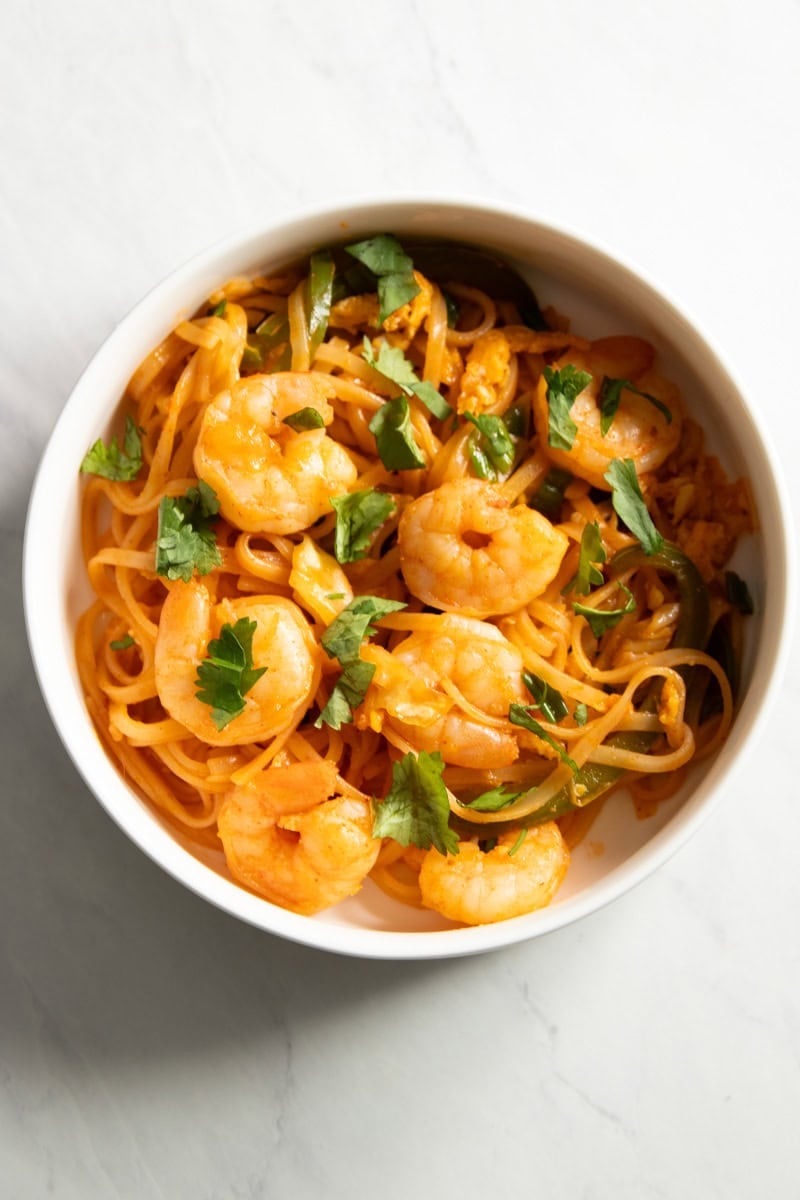
Instructions
This is a recipe that moves quickly; gather and prepare ingredients and equipment before starting for a smoother cooking process.
Check the rice noodle package instructions. If directed, start boiling the cooking water.
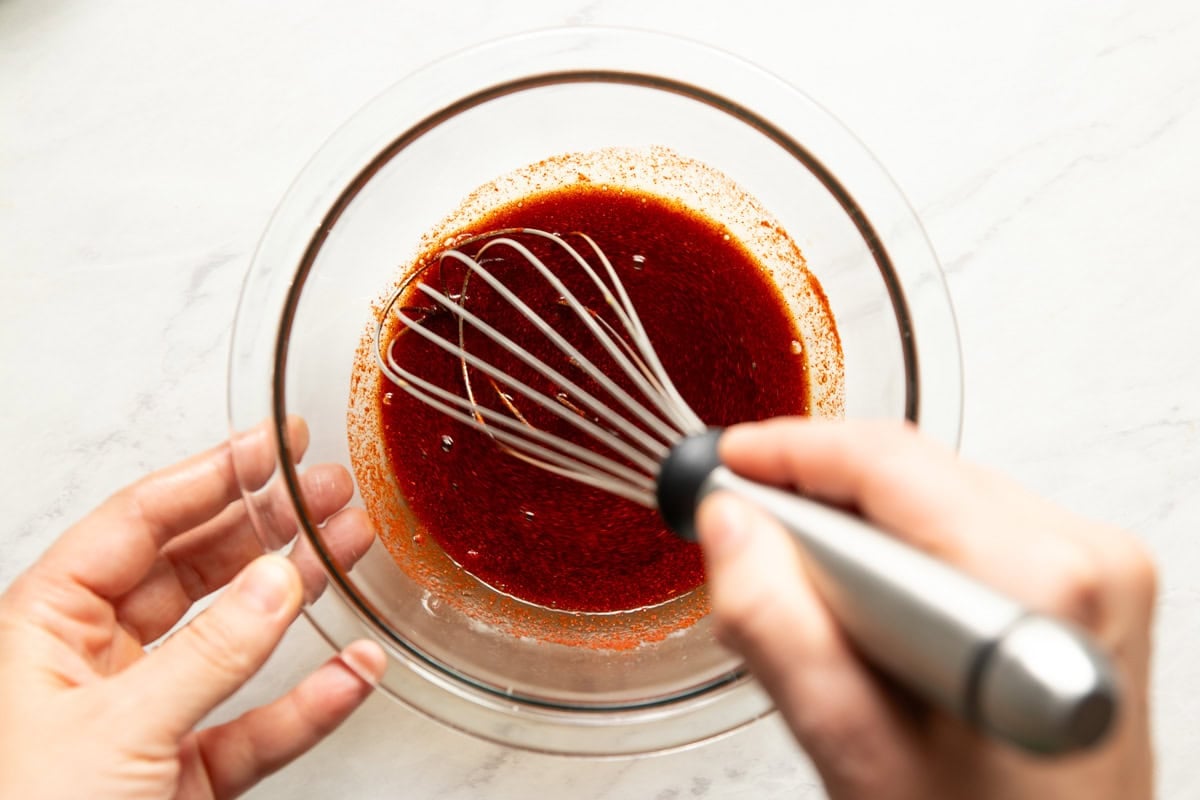
Whisk together sugar, rice vinegar, soy sauce (or tamari), fish sauce, and paprika in a small bowl.
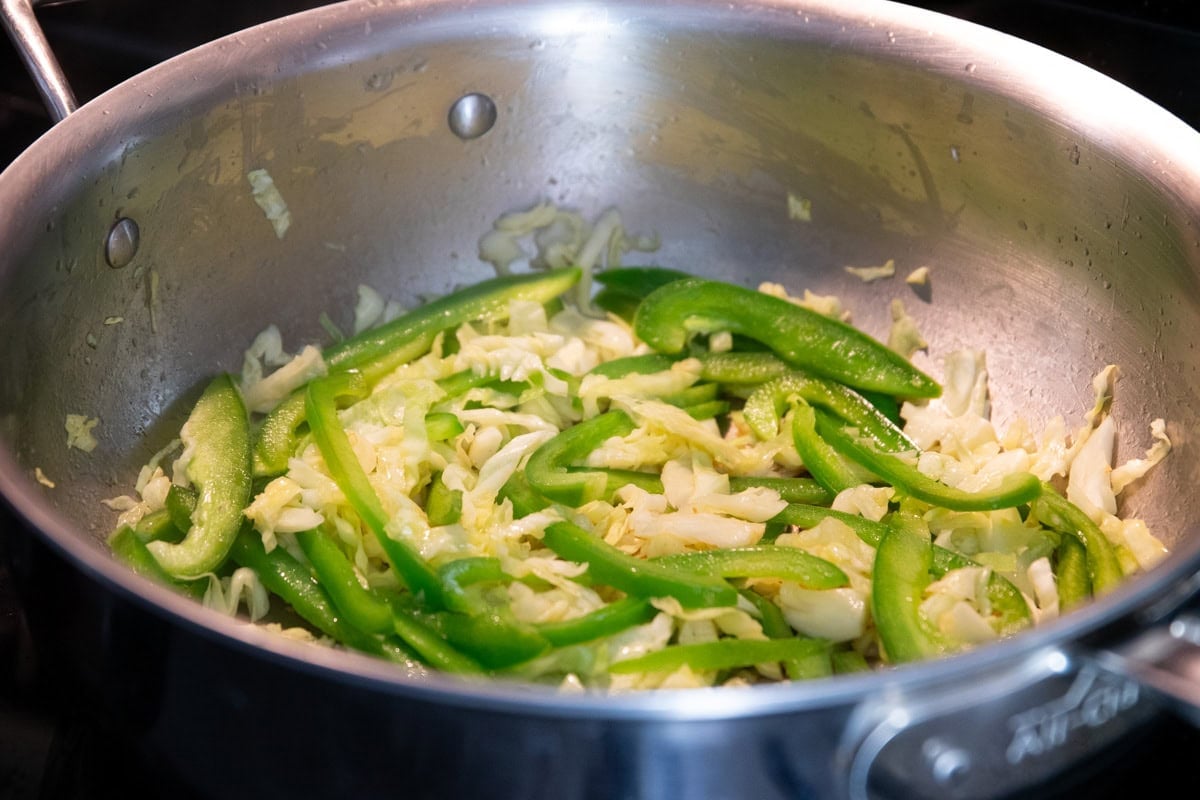
Heat 2 tablespoons garlic-infused oil in a large skillet over medium heat. Once the oil is hot, add the bell pepper slices and cabbage. Cook for 3 to 5 minutes or until the veggies start to soften.
While the peppers cook, prepare the rice noodles according to the package instructions. Drain.
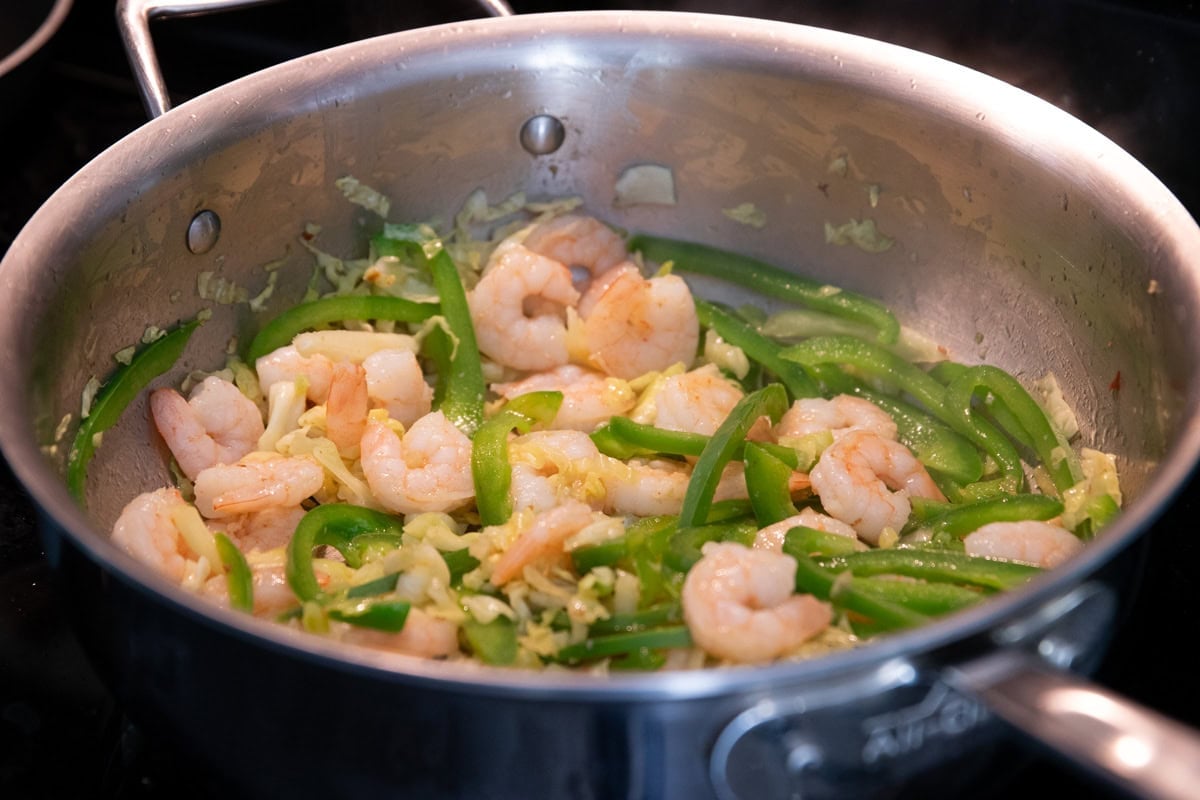
Once the peppers start to soften, add the shrimp to the skillet. Cook for 2 to 4 minutes or until the shrimp start to turn opaque pink and are almost cooked through. Add the sauce and cook for about 1 minute or until the shrimp are cooked and the sugar has dissolved. Reduce the heat to low.
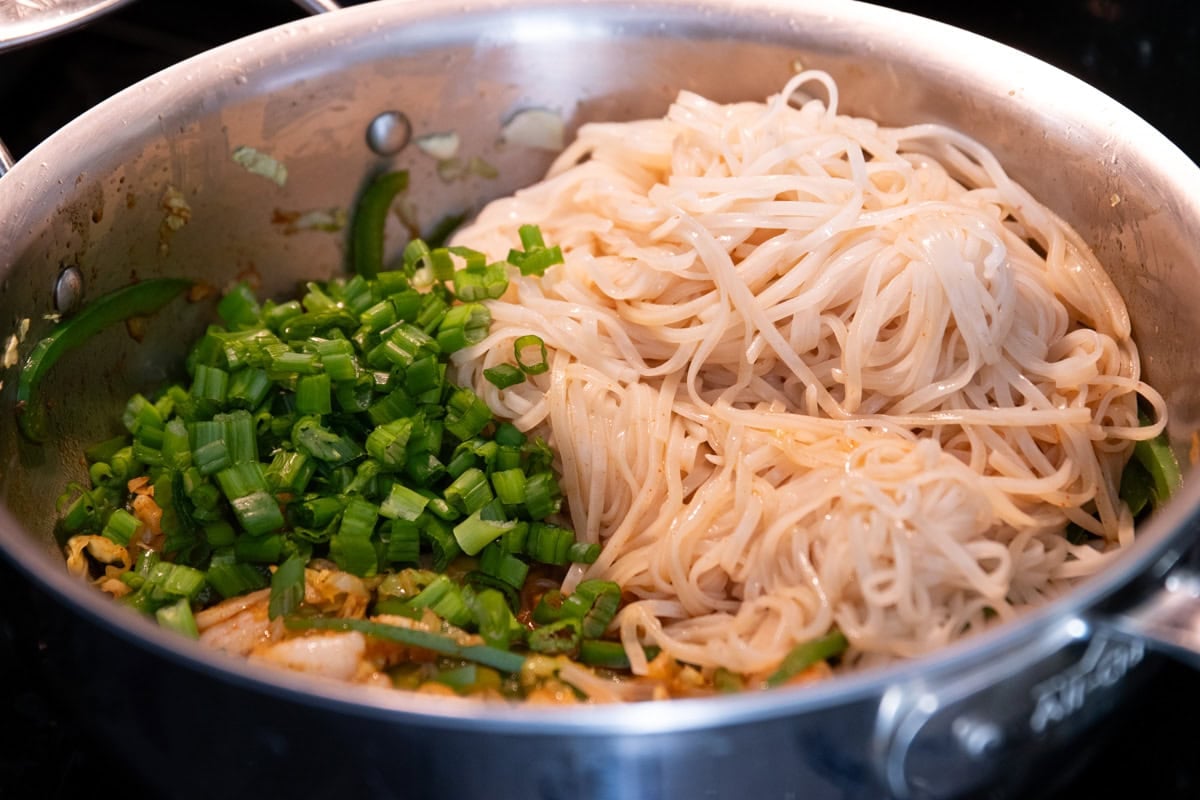
Stir in the noodles and green onion tops. Cook until everything is hot. Then, remove from the heat.
Optional: Heat the remaining 1 teaspoon of garlic-infused oil over medium-high heat in a small nonstick skillet. Once hot, add the egg and cook, scrambling with a silicone spatula, until done. Stir into the noodle mixture.
Serve warm, topped with optional cilantro leaves.
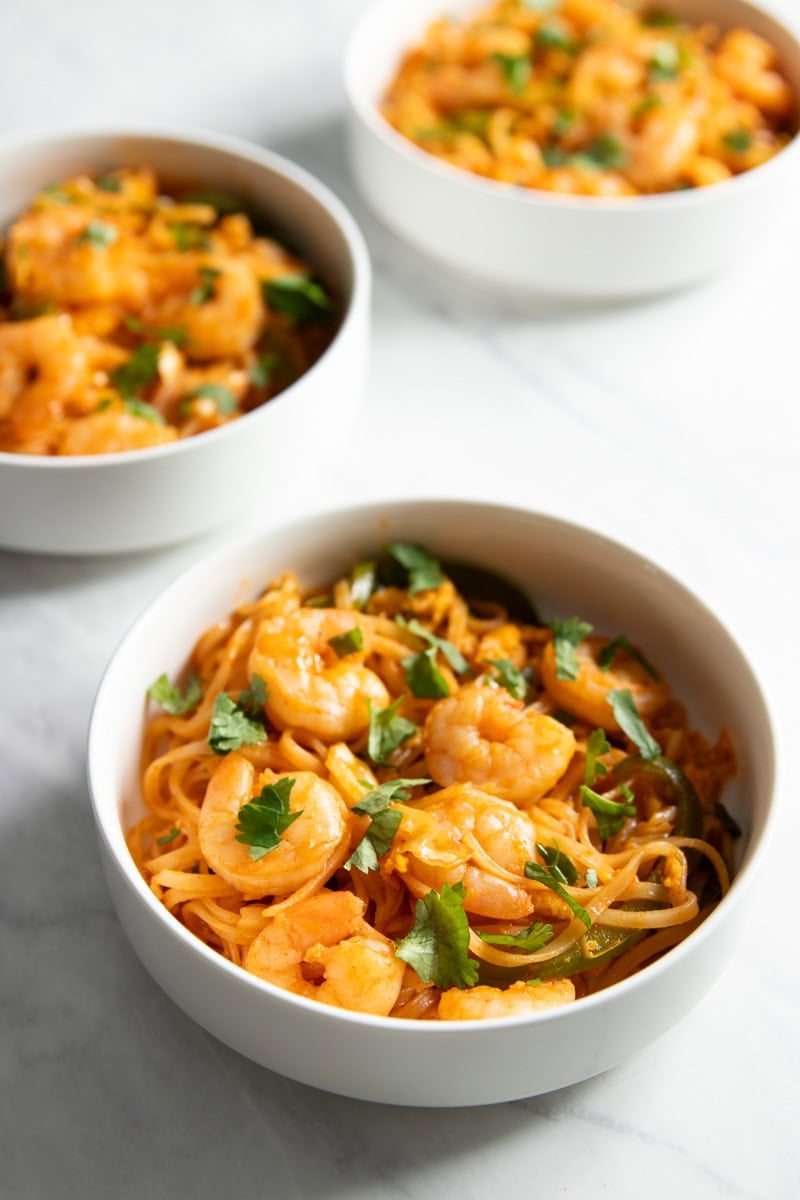
Similar recipes
- Low FODMAP Shrimp Stir Fry with Bell Peppers
- Low FODMAP Shrimp & Green Beans
- Low FODMAP Spicy Lemon Pasta with Shrimp
Recipe
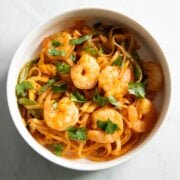
Low FODMAP Pad Thai with Shrimp
- Total Time: 30 minutes
- Yield: 4 servings
- Diet: Low Lactose
Description
This 30-minute Low FODMAP Pad Thai with Shrimp is a Thai restaurant-inspired dish featuring rice noodles, shrimp, a simple sauce, and FODMAP-friendly amounts of cabbage and green bell peppers.
Ingredients
- 8 ounces uncooked rice noodles, such as Thai Kitchen Brown Rice Noodles
- ¼ cup granulated sugar
- 2 tablespoons plain rice vinegar
- 2 tablespoons reduced-sodium soy sauce (or tamari for gluten-free)
- 1 tablespoon fish sauce
- 2 teaspoons ground paprika
- 2 tablespoons + 1 teaspoon garlic-infused olive oil, divided
- 1 medium (225 grams) green bell pepper, thinly sliced
- 1.5 cups shredded green cabbage
- 1 pound (454 grams) uncooked medium or large shrimp, peeled and deveined
- ½ cup sliced green onion tops (green parts only)
- 1 large egg, whisked - optional
- Chopped fresh cilantro leaves - optional garnish
Instructions
This is a recipe that moves quickly; gather and prepare ingredients and equipment before starting for a smoother cooking process.
- Check the rice noodle package instructions. If directed, start boiling the cooking water.
- In a small bowl, whisk together sugar, rice vinegar, soy sauce (or tamari), fish sauce, and paprika.
- Heat 2 tablespoons garlic-infused oil in a large skillet over medium heat. Once the oil is hot, add the bell pepper slices and cabbage. Cook for 3 to 5 minutes or until the veggies start to soften.
- While the peppers cook, prepare the rice noodles according to the package instructions. Drain.
- Once the peppers start to soften, add the shrimp to the skillet. Cook for 2 to 4 minutes or until the shrimp start to turn opaque pink and are almost cooked through. Add the sauce and cook for about 1 minute or until the shrimp are cooked and the sugar has dissolved. Reduce the heat to low.
- Stir in the noodles and green onion tops. Cook until everything is hot. Then, remove from the heat.
- Optional: Heat the remaining 1 teaspoon of garlic-infused oil over medium-high heat in a small nonstick skillet. Once hot, add the egg and cook, scrambling with a silicone spatula, until done. Stir into the noodle mixture.
- Serve warm, topped with optional cilantro leaves.
Notes
Low FODMAP Serving: One serving of this recipe (¼ recipe // about 1.5 cups // 225 grams) uses low FODMAP amounts of ingredients at the date of publication. Individual tolerance may vary, and low FODMAP servings may change. For more information on specific ingredients, please refer to the Monash FODMAP App or check out the "FODMAP Notes" section (above the recipe).
Fish sauce: Add more to taste, up to 2 tablespoons per serving.
- Prep Time: 15 minutes
- Cook Time: 15 minutes
- Category: Main Dish
- Method: Skillet, Stovetop
- Cuisine: Thai Inspired
Food safety
Some people develop IBS after having gastroenteritis (commonly referred to as a “stomach bug” or the “stomach flu”.) Practicing food safety is one way to help prevent many infections that can lead to gastroenteritis. Here are some food safety tips:
- Cook shellfish, including shrimp, to a minimum temperature of 145 °F (63 °C)
- Do not use the same utensils on cooked food that previously touched raw shellfish
- Wash hands after touching raw shellfish
- Don't leave food sitting out at room temperature for extended periods
- Never leave cooking food unattended
- Always have good ventilation when using a gas stove
See more guidelines at USDA.gov.
94
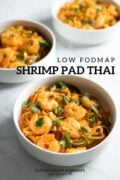
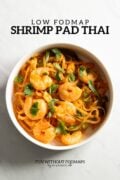
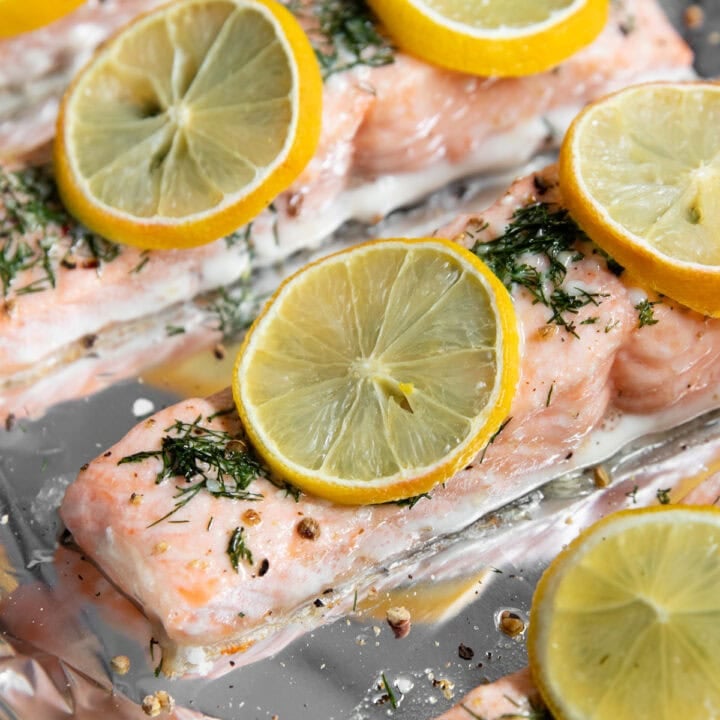
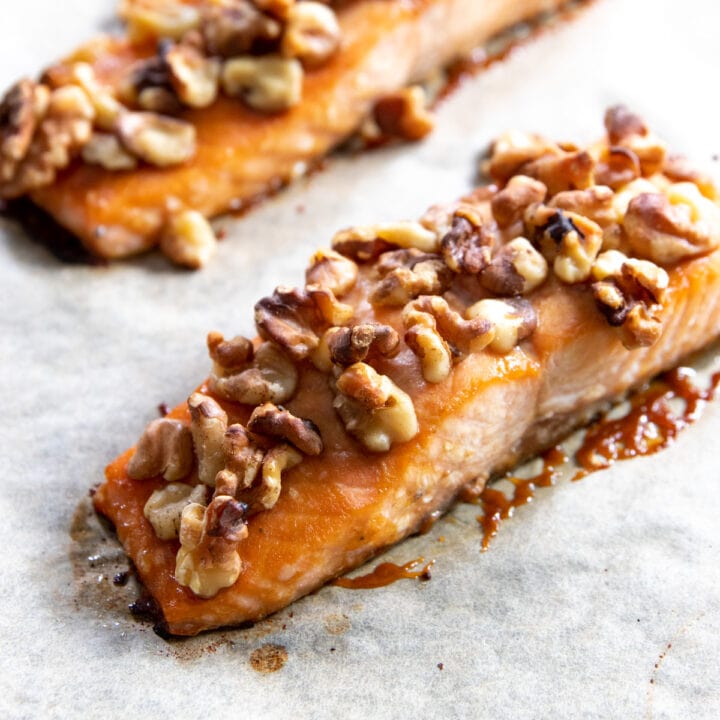
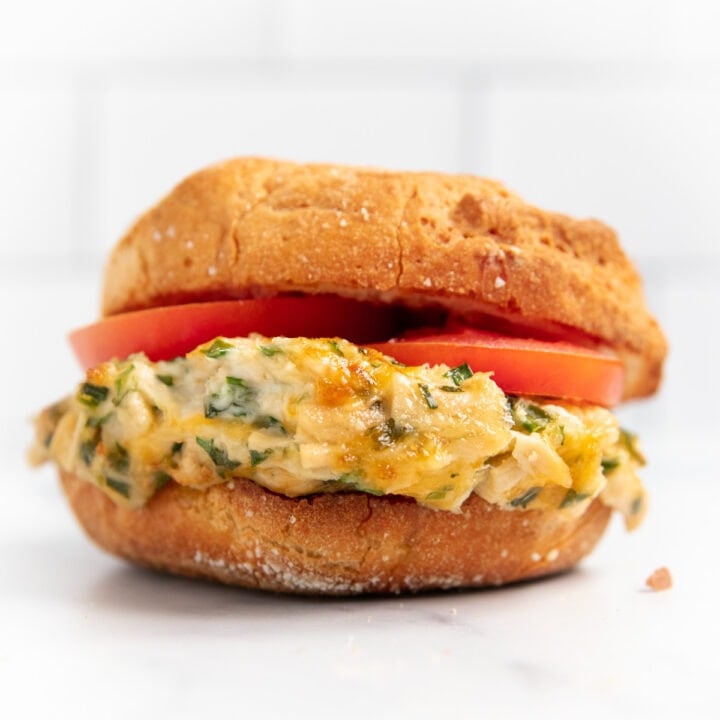

Debbie says
The recipe was easy but too sweet. I was wondering if you could cut back on the sugar. Or could you suggest another sauce.
Em Schwartz, MS, RDN says
Hi Debbie, the sugar in the sauce can pretty easily be adjusted to fit your preference. Half the sugar might be a good place to start. -Emily
Julie says
We love the original version of this recipe. My husband needs a low-fodmap diet and he struggled for a long time until we found recipes, many yours, that had flavor. The original version is one we've made several times and the whole family loves it. Is there any way to get access to it?
Em Schwartz, MS, RDN says
Thanks for letting me know, Julie. I will email you the previous version. For anyone reading and wondering why I made (in my mind, minor) changes, sometimes I need to make updates to recipes due to changes in FODMAP status of foods. In this recipe I replaced red bell pepper with green and slightly reduced the paprika to leave some FODMAP wiggle room. When I make updates, I also take previous feedback into consideration. In this case I reduced fish sauce, with the note to add more if desired. I am no longer able to source bean sprouts locally. So, I switched those out for cabbage. Thanks for understanding. -Emily
Martha says
Made exactly as written with a little less sugar. Really great! Will be in regular rotation! New to FODMAP so can’t wait to try your other recipes.